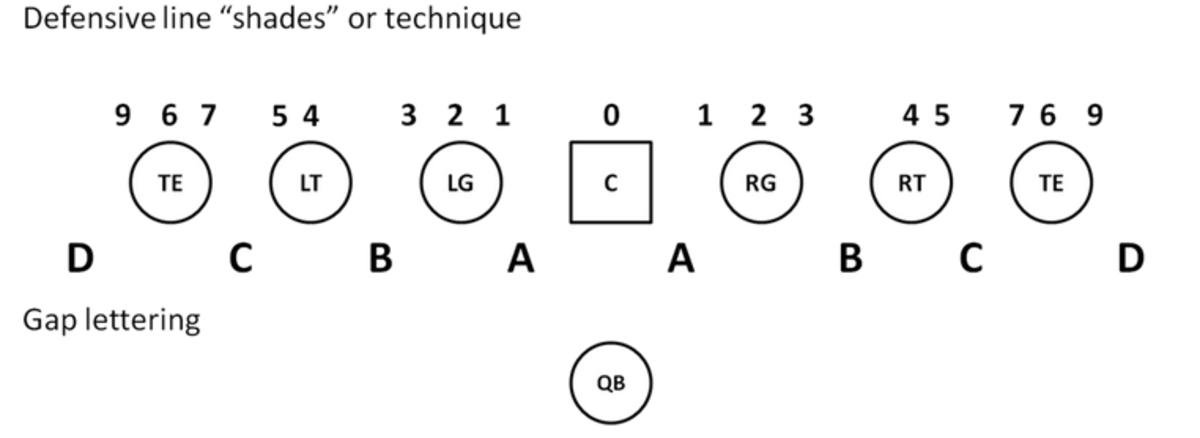Gus Glossary: Breaking Down the Roles at Edge Rusher--Run Defense
The Indianapolis Colts have made a new hire at defensive coordinator, as they have agreed to terms with long time coach Gus Bradley. In this series for the site, I will be defining some important terms and roles for this defense to give you all a better understanding of them when they pop up in future articles.
Continuing the current run of articles we are on with this series, let's take a look at the edge rushers on the defensive line. I was planning to break down the edge roles in both run defense and rushing the passer, but I ultimately decided to split it up into two separate articles.
So today, let's dive into the drastically different roles in run defense for the Colts' edge rushers in 2022 and discuss where each player is likely to line up next season.
Defensive Line Gaps
Prior to jumping into the meat of this article, it is important to define some terms. I posted this in the last article as well, but it is important to keep this information in mind as we talk about gap assignments and roles:
- 0-Technique: Defender is face up with the center.
- 1-Technique: Defender lines up on the center's outside shoulder.
- 2i-Technique: Defender lines up on the guard's inside shoulder.
- 2-Technique: Defender is face up with the guard.
- 3-Technique: Defender lines up on the guard's outside shoulder, between the guard and the tackle.
- 4i-Technique: Defender lines up on the tackle's inside shoulder.
- 4-Technique: Defender is face up with the tackle.
- 5-Technique: Defender lines up on the tackle's outside shoulder.
- 7-Technique: Defender lines up on the inside shoulder of the tight end.
- 6-Technique: Defender is face up with the tight end.
- Wide Nine-Technique: Defender lines up outside the furthest blocker on the line.

Matt Eberflus' Defense
In order to discuss the changes that are coming for edge defenders in 2022, let's briefly talk about their roles last year in Matt Eberflus' defense. Eberflus deployed a fairly standard 4-3 defense for most of his time in Indy, with the strong-side defensive end mainly being in a 5-technique or 7-technique alignment and the weak-side end being out in a 7-technique or in a wide-nine.
The roles were fairly straightforward in the run game for these defensive ends; get up the field, control the gap, and identify the ball. It was gap assignment football off of the edge, with the main priority being to maintain disciple and keep the opponent's rushing attack boxed in. The strong-side defensive end needed to control the C-gap while the weak-side defender typically controlled the D-gap off of the edge.
— Not Zach’s Burner (@NotZachsBurner1) July 28, 2022
For this Colts' defense, the style meshed really well with the team's personnel. The Colts had one of the better run defenses in the NFL during Eberflus' tenure, and he really played to the strength of his bigger, run defending defensive ends. It was a simplistic scheme, but it allowed the defensive ends to play gap-control football to create easy plays for the linebackers.
While this defense was typically asked to box the opposing run game inside, Eberflus did like to mix in a run blitz called "Patterns." In patterns, the play-side defensive end and defensive tackle would cross the face of the offensive lineman in front of them. This would create an optimal angle for the linebackers to crash down on where the run play is being funneled to.
Here is a play against the San Francisco 49ers that illustrates it well. Al-Quadin Muhammad and Tyquan Lewis crash down on the run, which effectively funnels the play right into the arms of Bobby Okereke.
— Not Zach’s Burner (@NotZachsBurner1) July 28, 2022
So, in summary, Eberflus liked to utilize bigger defensive ends as pawns in the run game. He wanted sturdy players that could hold up at the point of attack and win their gaps early and often. These ends were used to funnel run plays to the Colts' playmakers at linebacker and make life easier for those second-level defenders.
Gus Bradley's 4-3 Under
Switching gears over to Gus Bradley, the defensive ends will have a much more prominent role in run defense rather than being just cannon fodder (at least the big end will). The biggest difference will be in how they are lined up.
I talked at length in the last article about how Gus Bradley's defense is more of a hybrid 4-3/3-4 defense compared to the traditional 4-3 style of Eberflus' scheme. When Bradley's defense shifts into a 3-4 under look (where the SAM linebacker comes down to the line of scrimmage), then the big end shifts into more of a defensive tackle-like role.
In these looks, the big end/strong-side defensive end can align anywhere from 4i-technique all the way out to 7-technique. They will usually be assigned to the C-gap, but can also jump into the B-gap on occasion. The LEO/weak-side defensive end will typically stay out in a wide-nine technique, but can shift down into a 7-technique depending on offensive personnel.
In this picture below, Maxx Crosby is the big end in a 7-technique. Yannick Ngakoue is out in a wide-nine as the LEO on the backside of the play.

To illustrate how far down the big end can slide in these under looks, here is a play against the Cleveland Browns where Crosby moved all the way down to more of a 4i-technique as the SAM linebacker occupied his spot off of the edge.

Gus Bradley's 4-3 Over
The alignments and assignments in 4-3 over are fairly similar to how Eberflus had it in Indy over the past few seasons. The big end will occupy the C-gap in a 6-technique or 7-technique, while the LEO is still popped out in the wide-nine alignment.
Pretty straightforward stuff when looking at this picture below. The biggest difference, which we will talk about next, is how these players will be used in these gaps and assignments.

Big End (Strong-Side Defender)
Notable Past Players in this Role: Patrick Kerney (2009), Jared Odrick (2015), Joey Bosa (2017-2020), Maxx Crosby (2021)
2022 Candidates: Kwity Paye, Tyquan Lewis, Dayo Odeyingbo
The big end role is one that has evolved quite a bit over the years in Bradley's scheme. It used to be more of a defensive tackle-type position, with the players typically being around 280-300 pounds. Once he arrived in San Diego, the position morphed into a versatile edge rusher that is also strong against the run.
The premise is similar to Eberflus' strong-side defensive end, as this role is for sturdy players that can win in the C-gap off of the edge. The main difference now is how these players are taught to attack that gap. With Eberflus, the defensive ends were told to control the gap and identify the ball after the gap is won. In Bradley's scheme, the goal is to obliterate the gap and focus on the ball later.
While I'm not saying that Bradley's way of attacking the run game is better by any means, it is a run defense that prioritizes disruption and attacking on every play. Maxx Crosby occupied this role last season and he was simply dominant, raking up 13 tackles for a loss in the run game.
As you can see in this clip below, Crosby isn't focused on controlling his gap and reading the play. He is firing off the ball, through his gap, and causing disruption.
— Not Zach’s Burner (@NotZachsBurner1) July 28, 2022
While there has been a lot of talk this offseason about Bradley wanting to deploy two LEO's this upcoming season, I think he will likely do what he did last year with Maxx Crosby. Kwity Paye will be able to jump out in some wide-nine looks in passing situations, but he will likely be in more 7-technique looks on rushing downs.
If any player on the Colts is capable of replicating what Crosby did in the run game last year, it's Kwity Paye.
— Not Zach’s Burner (@NotZachsBurner1) July 28, 2022
LEO (Weak-Side Defender)
Notable Past Players in this Role: Chris Clemons (2010-2012, 2014-2015), Bruce Irvin (2012), Jason Babin (2013), Yannick Ngakoue (2016, 2021), Melvin Ingram (2017-2020)
2022 Candidates: Yannick Ngakoue, Ben Banogu, Bryan Cox Jr.
The talk of the offseason for Colts' reporters and fans has been the LEO position. The LEO is the overly-fantasized pass rushing role that became the next big thing in the NFL with Bradley's Legion of Boom back in 2012. The LEO is basically a weak-side defender that's main role is to rush the passer.
This doesn't mean that this player can just take run plays off, but it is a far cry from Eberflus' defense where he wanted both defensive ends to be stout run defenders. The LEO typically stays out in a wide-nine on run plays, only shifting inside to a 7-technique when there is a tight end occupying their side.
The LEO's main priority in the run game is to maintain discipline on the backside and control the outside edge. Outside of that, just don't get blown off of the ball (and win as a pass rusher) and the LEO is doing their job well enough.
— Not Zach’s Burner (@NotZachsBurner1) July 28, 2022
Final Thoughts
The Indianapolis Colts continuously produced great run defenses during Matt Eberflus' tenure. While his scheme was effective at containing run plays, it never took that next step to become a defense that could disrupt/destroy an opposing run game. While Gus Bradley's defense is a bit more risky, it does emphasize an attack-first mentality aimed at punishing offenses for rushing the ball.
While the edge rushers in this new scheme will be responsible for the same gaps, they will be asked to attack differently. The days of controlling a gap and ID-ing the run are over. It is now attack, attack, attack on every play.
The main beneficiary of this change, in the run game, is Kwity Paye. Maxx Crosby was a menace in run defense for the Raiders this past season and Paye should be able to replicate that success in 2022. I expect to see a ton of tackles for a loss for the second year edge defender this year.
Need your fill on daily Colts' content? Head over to the Locked On Colts' YouTube channel where Jake Arthur and myself hit on all the major topics surrounding this team. Hit that subscribe button while you are there!
Follow Zach on Twitter @ZachHicks2.
